 Open Access
Open Access
ARTICLE
Study on Two-Tier EV Charging Station Recommendation Strategy under Multi-Factor Influence
School of Information and Communication Engineering, Nanjing Institute of Technology, Nanjing, 211167, China
* Corresponding Author: Peng Geng. Email:
Journal on Artificial Intelligence 2023, 5, 181-193. https://doi.org/10.32604/jai.2023.046066
Received 17 September 2023; Accepted 27 November 2023; Issue published 28 December 2023
Abstract
This article aims to address the clustering effect caused by unorganized charging of electric vehicles by adopting a two-tier recommendation method. The electric vehicles (EVs) are classified into high-level alerts and general alerts based on their state of charge (SOC). EVs with high-level alerts have the most urgent charging needs, so the distance to charging stations is set as the highest priority for recommendations. For users with general alerts, a comprehensive EV charging station recommendation model is proposed, taking into account factors such as charging price, charging time, charging station preference, and distance to the charging station. Using real data from EV charging stations and ride-hailing vehicles in Xiamen City, Fujian Province, simulation analyses are conducted using Python for different periods of the day. The research results show that the stability of the multi-factor recommendation model in terms of service density variance, coverage rate, price cost, and distance cost outperform single-factor models. This indicates that our composite multi-factor recommendation model has significant practical value in resolving the clustering phenomenon caused by unorganized EV charging, optimizing the EV charging service system, and improving user satisfaction.Keywords
In the introduction of this academic paper, the widespread adoption of EVs and the rapid development of charging facilities have made the issue of EV charging a hot research topic. Unorganized charging of EVs can cause a clustering effect, which can afect the stability of the power grid. Therefore, effectively controlling the charging behavior of EV users to match the EV charging load with the power supply capacity of the grid is an important research goal.
In the field of EV charging coordination strategy, literature [1] focused on the total distance, optimized the path planning model, and constructed a charging network optimization model. Literature [2] proposed a charging scheduling method based on Markov chains, combined with the uncertainty of charging load, to effectively reduce the peak-valley differences and lower the user charging cost. Literature [3] proposed charging recommendation strategies that minimize the total time by considering the GPS trajectories of taxis. Most of these charging recommendation algorithms focus on achieving optimization in one direction, such as reducing charging distance [1], reducing charging cost [2], and reducing charging time [3], etc., and it is difficult to make a recommendation scheme that can achieve an overall balance. Literature [4] proposed a dynamic navigation strategy based on charging price guidance with the optimal cost of EV driving time and the optimal cost of charging as the objective function, which considered the cost and time comprehensively, but failed to consider the power shortage and power surplus vehicles separately, and ignored the diversity of user needs.
Therefore, this paper proposes a two-tier recommendation model for EV charging stations that integrates multiple factors, which considers EVs hierarchically according to power level, for users with lower power, the closest charging station is recommended. For users with higher power, a comprehensive recommendation is made by considering the user’s charging cost, charging time, user’s preference of charging stations, and user’s distance to the charging station. Aiming to achieve the equalization of service density of charging stations, reduce the variance of service density of charging stations, and solve the clustering effect caused by disorderly charging of electric vehicles, the effectiveness of this recommendation strategy is verified by simulating and analyzing the GPS data of electric vehicle charging stations and networked vehicles in Xiamen, Fujian Province.
Before constructing the recommendation strategy model, the most important thing is the selection of influencing factors, this paper selected four influencing factors that affect the user’s choice of charging station are: charging price, charging time, preference and distance.
The charging cost of EV charging is undoubtedly the most important at the user level. The price cost reflects the cost that EV users have to pay during a charging process, which mainly consists of two parts: the charging cost and the service fee. The sum of the two is the actual price per kilowatt-hour (kWh), which is measured in dollars per kWh.
Charging time is undoubtedly one of the factors that users are concerned about, but it is impossible to accurately calculate charging time due to the wide range of performance of individual chargers and the different charging specifications of individual vehicles. Fast chargers often indicate that charging can be done in an extreme amount of time, so this experiment uses the number of fast chargers in the station to represent charging time.
User’s preference of charging stations is also a consideration; people often tend to go to charging stations they have used before and are satisfied with. However, the data on user preference for charging stations is often unknown to us, but it may be that such charging stations are often not very far away, so in this paper we select charging stations within a certain range and initialize their preference on a scale of 1–10, where 10 means they have been there before and are very satisfied, and 1 means they have only been there before and are not very satisfied.
Finally, distance is an even more important factor to consider because when users need to charge, they often do not have much driving distance left, so the shortest charging distance tends to be more attractive to users.
3 Two-Tier Charging Station Recommendation Model under Multi-Factor Conditions
Building upon preliminary research, this paper constructs a two-tier recommendation model for charging station suggestions in multi-factor environments, and further establishes corresponding evaluation metrics for in-depth discussion. The research scheme is illustrated in Fig. 1. Firstly, the spatio-temporal distribution data of Electric Vehicles (EVs) in Xiamen is processed using the DBSCAN clustering algorithm. Subsequently, the EVs are subjected to initial power allocation, with user alerts levels determined based on the State of Charge (SOC). EVs with a SOC below 20% are classified as high-level alerts, and recommendations are made based on the distance to the charging station.
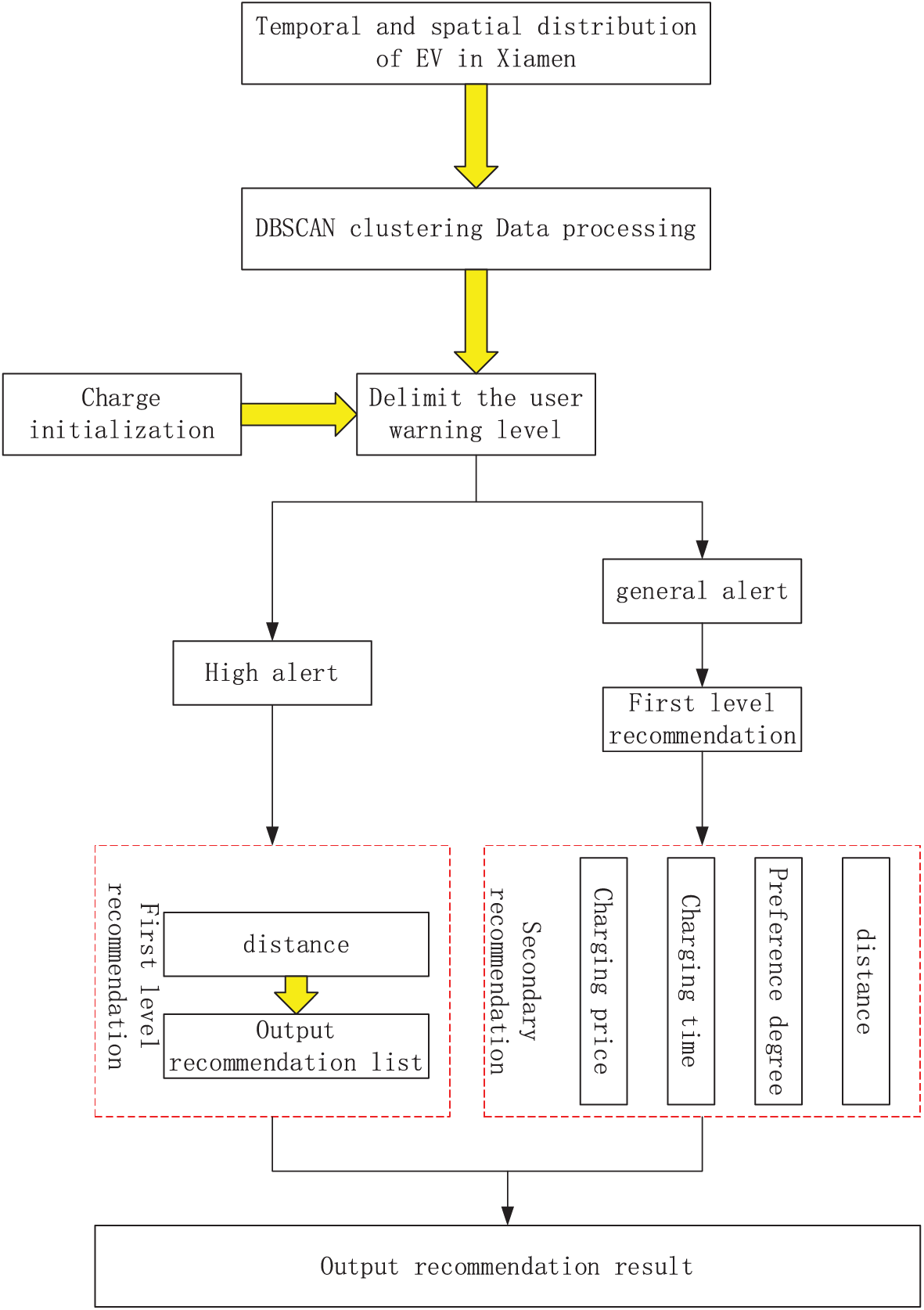
Figure 1: Research scheme block diagram
In the second tier, during the general alerts phase, EVs with a SOC between 20% and 40% retain the top ten stations from the first tier recommendations as a recommendation list. Subsequently, by considering charging price, charging time, charging station preference, and distance, a fuzzy planning method is employed to calculate a comprehensive score for each station, thereby enabling secondary recommendations. The symbols and their meanings involved in this article are shown in Table 1.

The DBSCAN (Density-Based Spatial Clustering of Applications with Noise) algorithm proposed by Ester et al. [5] is an unsupervised learning clustering algorithm widely used in machine learning and data mining. The main advantage of DBSCAN lies in its lack of prior assumptions about the shape and number of clusters, and its effective handling of noisy data. DBSCAN is based on the concept of density. The algorithm classifies data points in high-density areas as a category and considers data points in low-density areas as noise. DBSCAN has two main parameters: the neighborhood radius (epseps) and the minimum number of samples (min_samplesmin_samples). The neighborhood radius is used to determine the size of the neighborhood for density calculation, while the minimum number of points is the minimum number of data points required to form a cluster. The basic steps of the algorithm are as follows:
(1) Randomly select an unvisited point and calculate all points within its epseps neighborhood.
(2) If the number of points in the epseps neighborhood of this point is greater than or equal to min_samplesmin_samples, create a new cluster and add all points in the neighborhood to this cluster. These points are marked as visited.
(3) If the number of points in the epseps neighborhood of this point is less than min_samplesmin_samples, mark this point as noise.
(4) Repeat steps (2) and (3) for all points in the neighborhood that have not yet been visited.
(5) This process continues until all points have been visited.
Due to the large amount of online car data, the recommendation results of cars with similar locations are often the same, and repeating the recommendation will get a lot of redundant data, so this experiment uses DBSCAN clustering to cluster the cars with similar locations, and randomly selects the location of a car from it for recommendation, which greatly reduces the redundancy of the experimental data, and the analysis of the results of the recommendation strategy is more effective.
3.2 Recommendation Model Construction
After battery power is initialized, alert levels are assigned based on each vehicle’s state of charge (SOC). In the first tier of high-level alerts, EVs with a SOC less than 20% are recommended based on distance to the charging station alone. In the second tier of general alerts, EVs with a SOC between 20% and 40% will initially retain the top ten recommended stations from the first tier as a recommendation list. Then, the optimal charging station is selected for recommendation based on charging price, charging time, charging station preference, and distance to the charging station. Importantly, the multi-objective planning problem facing various charging needs must be transformed into a single-objective task for solution under general alerts.
Fuzzy programming is a method for merging multiple objectives into a single objective. It can be used to handle situations where objectives and constraints are variable or uncertain. The core of fuzzy programming is the membership function. Suppose UU is the domain, if for any xx contained in UU, xx belongs to AA with a degree of ll(l∈[0,1]l∈[0,1]), then A is a fuzzy set of U, and ll is the degree of membership of xx to AA. If the membership function of the objective functions f1(x)f1(x), f2(x)f2(x),..., fn(x)fn(x) are respectively: l1l1, l2l2 ,..., lnln, then the membership function based on linear distribution can be expressed as follows [6–8]:
li={0fi≥max(fi)max(fi)−fimax(fi)−min(fi)min(fi)<fi<max(fi)1fi≤min(fi)(1)
Because the number of fast charges, preference and price, and distance are inversely related, the membership functions for these two factors are modified. The modified formula is as follows:
li={1fi≥max(fi)fi−min(fi)max(fi)−min(fi)min(fi)<fi<max(fi)0fi≤min(fi)(2)
Suppose the charging price is F, charging time is T, preference is P, and distance is D.
Then the user’s affiliation function for the distance to charging post i is:
li={0Di≥max(Di)max(Di)−Dimax(Di)−min(Di)min(Di)<Di<max(Di)1Di≤min(Di)(3)
The affiliation function of the user’s charging price for charging post i is:
li={0Fi≥max(Fi)max(Fi)−Fimax(Fi)−min(Fi)min(Fi)<Fi<max(Fi)1Fi≤min(Fi)(4)
The affiliation function of the user’s preference for charging post i is:
li={1Pi≥max(Pi)Pi−min(Pi)max(Pi)−min(Pi)min(Pi)<Pi<max(Pi)0Pi≤min(Pi)(5)
The user’s affiliation function for the charging time of charging pile i is:
li={1Ti≥max(Ti)Ti−min(Ti)max(Ti)−min(Ti)min(Ti)<Ti<max(Ti)0Ti≤min(Ti)(6)
In this way, the original multi-objective planning problem can be transformed into a class of fuzzy single-objective planning problems, and then each subordinate function is assigned a corresponding weight according to the importance of each objective function, and then linearly weighted [9]. Using a vector Z to represent the single objective function value, the optimal ideal value of the objective function can be expressed as:
minZ=max[∑ni=1λili](7)
In the above formula, λi represents the weight of the membership function li, where λi ≥ 0, and ∑ni=1λi=1.
4.1 Experimental Purpose, Principle and Process
This experiment constructs a two-tier recommendation model under the influence of multiple factors, with the aim of solving the clustering phenomenon caused by disorderly charging of electric vehicles, optimizing the charging service system of electric vehicles, and improving user satisfaction. First, this paper selects the data of network car rental in Xiamen, Fujian Province, and identifies the start time of the longest parking time of network cars in one day as the charging time, and to reduce the data redundancy caused by repeated recommendations, the data preprocessing is performed by using DBSCAN, which clusters the vehicles with similar locations into one vehicle. The EVs are then initialized with the power level and charging station preference. The user alert level is classified according to the initialized power SOC, and EVs with less than 20% power are classified as advanced alerts, which are recommended based on the distance to the charging station. EVs with power SOC between 20% and 40% are classified as ordinary warning level, and the top ten stations are kept as the recommendation list based on the recommendation results of the first tier first. Then, the fuzzy planning method is used to calculate a comprehensive score for each charging station by combining the price of the charging station, the number of fast charging piles in the charging station, the EV’s preference for the charging station, and the distance from the EV to the charging station to make the second-level recommendation. To avoid errors caused by weekends and non-weekends, the weekend and non-weekend data are processed separately. And considering that some charging stations implement segmented charging (as shown in Fig. 2), the charging time of the car is divided into 11 periods. Finally, we compared the recommendation model of this study with the one-factor recommendation model in the four evaluation indexes of service density variance, coverage, price cost, and distance cost. To ensure the reliability of the results, we conducted three simulations, and the results of each experiment were the average of 11 time periods, and the experimental results are shown in Figs. 3 and 4.
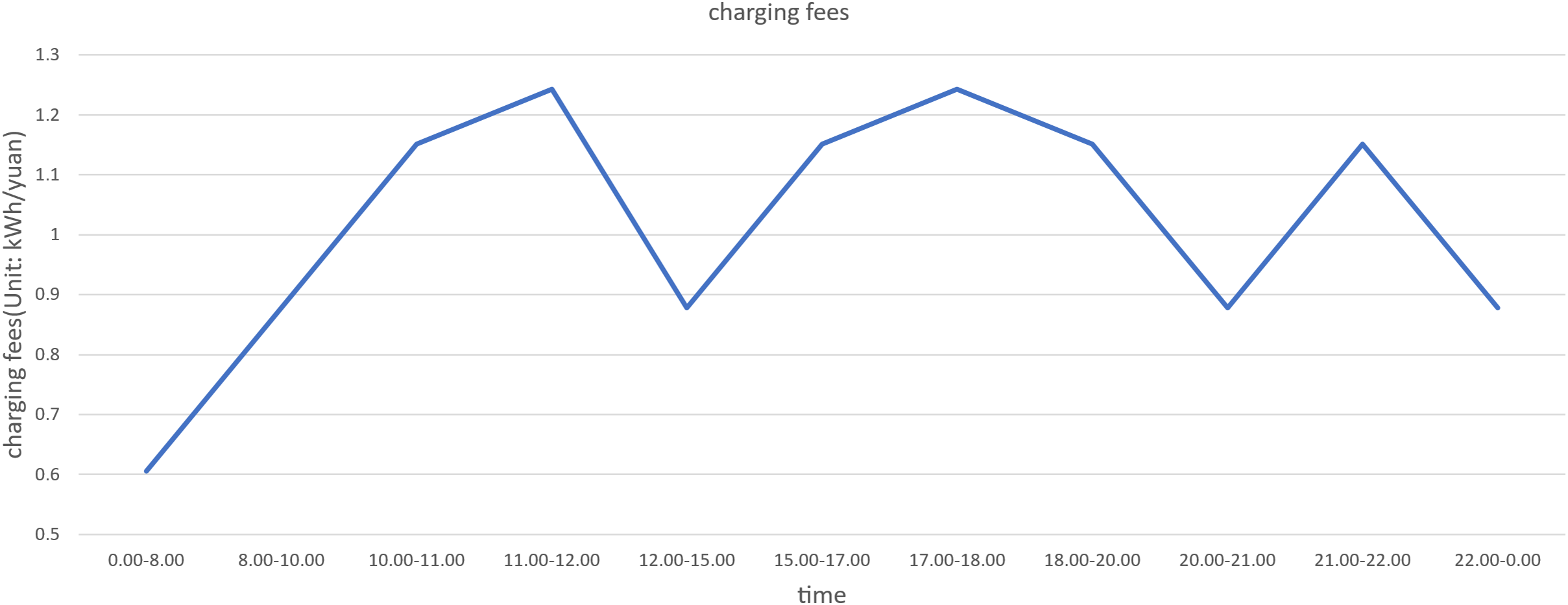
Figure 2: Changes in charging fees at different time periods (Unit: kWh/yuan)
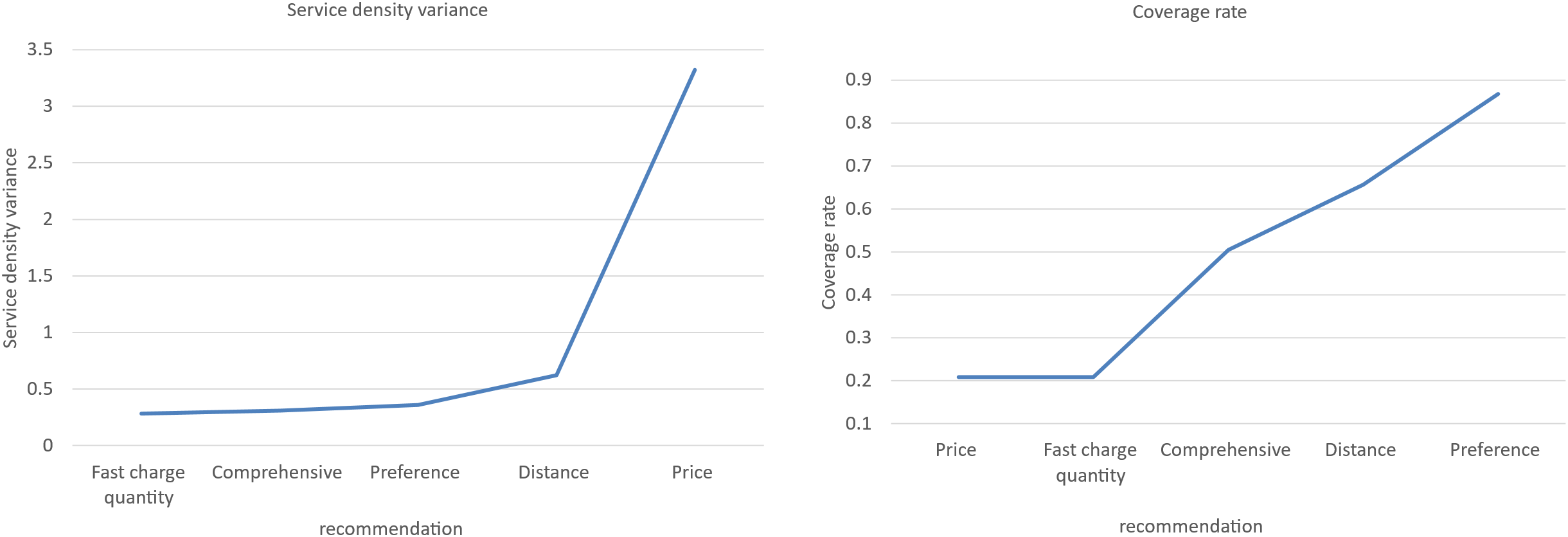
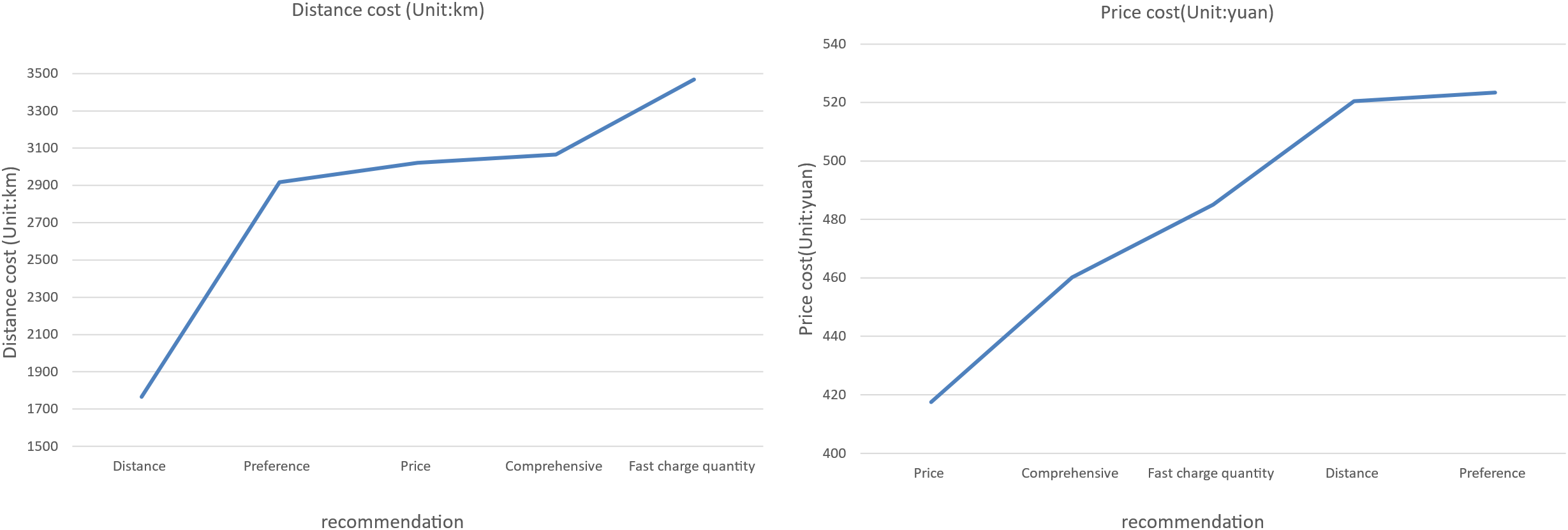
Figure 3: Schematic diagram of the comprehensive recommendation algorithm effect in Xiamen City during weekdays
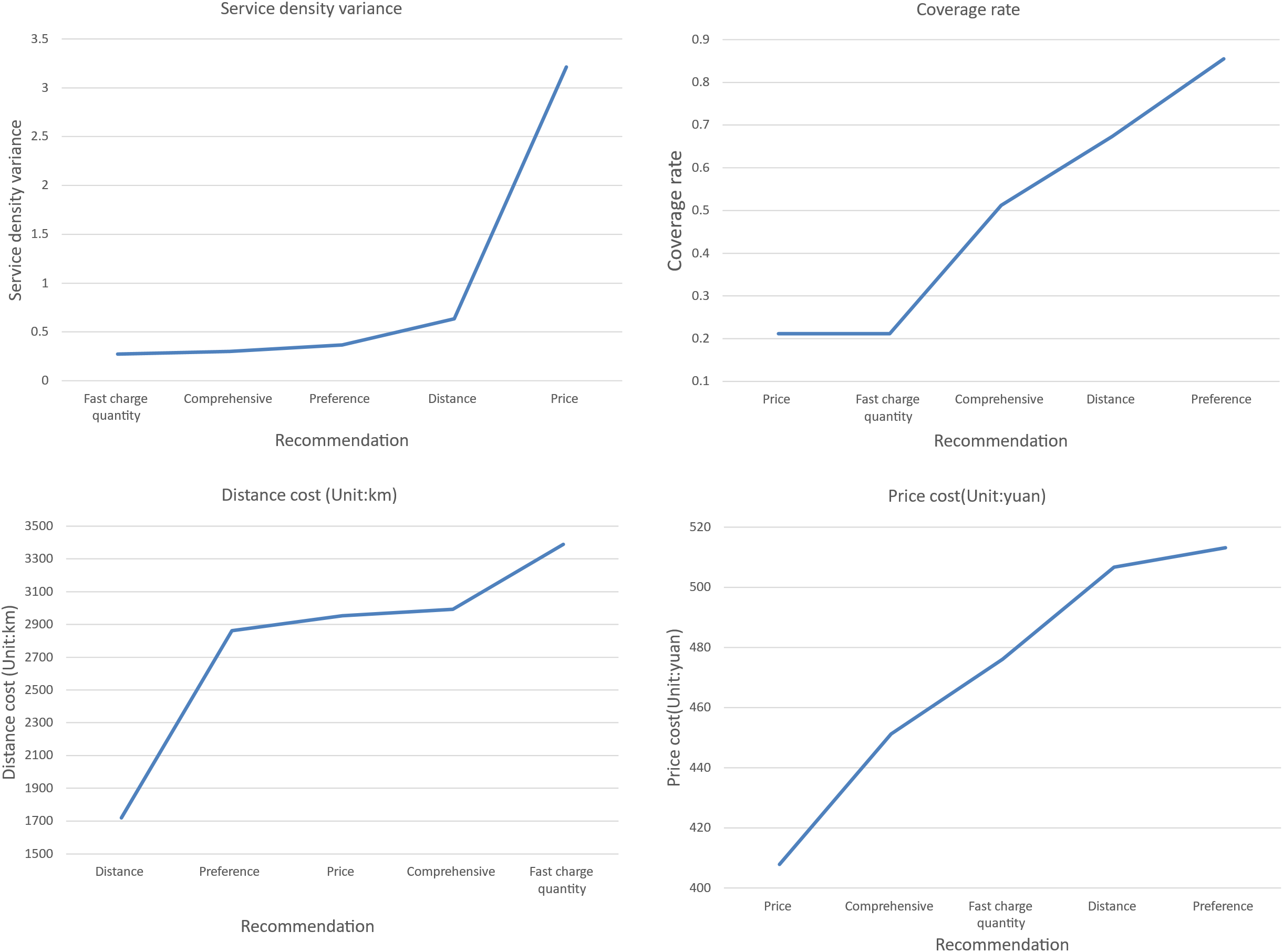
Figure 4: Schematic diagram of the comprehensive recommendation algorithm effect in Xiamen City during weekends
The experiment is written in Python in PyCharm 2021, and it is conducted on a computer equipped with 16 GB RAM and 11th Gen Intel(R) Core (TM) i5-11260H @ 2.60 GHz processor. The charging cost data of the charging station is obtained from “ChargeBar”, the latitude and longitude data is obtained from Baidu map api, and the geographic coordinate system is wgs84. The distance from the EV to the charging station is obtained from “OpenStreeMap”. It is used to obtain road network data for calculation. The GPS data of the network cars in Xiamen City, Fujian Province, on October 25 and October 26, 2019 were selected, and about 10,000 network cars operated every day in these two days.
The following assumptions were made when processing the Internet Car’s GPS data:
(1) Each online ride-hailing vehicle is an electric vehicle.
(2) Each online ride-hailing vehicle charges once per day.
(3) The start time of the longest parking duration in a day for each vehicle is considered as the charging demand time.
To prevent the data from being too concentrated, the cars are clustered using DBSCAN with eps = 0.1, min_samples = 10, where eps is the range of 0.1 km and min_samples is the minimum number of samples. After clustering, about 5000 vehicles have daily charging demand. Since the focus of this experiment is the comprehensive consideration of the recommendation strategy under multi-factors, these vehicles are randomly initialized with the charge in the ratio of 1:10 for users with normal and advanced warning of the charge. And the preference data is based on the latitude and longitude data to calculate the charging stations within 10 km and initialize five of them randomly from 1–10, and if there are less than five charging stations within 10 km, then initialize the preference for all charging stations within 10 km. The pre-processed network car data is shown in Table 2 and the preference degree data is shown in Table 3.


4.4 Simulation of Two-Tier Recommendation Model
This study explores a two-tier recommendation model, the first tier recommendation model, which will directly recommend the nearest charging station considering the urgency of low power. And the second tier recommendation in order to meet the macro-regulation needs of the grid, we set the weight of charging price as the highest, while the weight of distance is set as the lowest because it has been screened by the first tier. And due to the high charging efficiency, fast charging station has become the first choice of 96% of users, so the weights of charging price, charging time, charging station preference and charging station distance are 0.38, 0.32, 0.25 and 0.05, respectively. The recommendation output is shown in Table 4.

This model integrates user satisfaction and operator’s demand, and two evaluation indicators, utilization rate balance degree and charging cost, are set. In order to avoid chance, two factors are selected for each indicator to evaluate the model, as shown in Table 5. The specific indicators are as follows.

(1) Service density variance: Under normal circumstances, charging stations with superior geographical locations and high pedestrian traffic are often over-utilized. Conversely, charging stations with inferior geographical locations and low pedestrian traffic are often idle, resulting in underutilization of charging resources. In this study, the service density of charging stations is used as a measure of the utilization rate of charging stacks, specifically expressed as formula (8).
ρ=NiN(8)
In the formula: Ni represents the number of vehicles recommended for charging at the station; N represents the total number of charging piles at the station.
When the service density of different charging stations is closer, the overall balance of the utilization rate of charging piles is higher. Therefore, the variance of the service density of multiple charging stations is calculated, with the calculation formula as follows. If the obtained variance value is small, it indicates that the service density of the charging stations is relatively close, that is, the utilization rate of the charging piles is more balanced.
Sρ=1nn∑i=1(ρi−1nn∑i=1ρi)2(9)
(2) Coverage rate: In addition to the variance of service density, coverage rate is also an important indicator used to measure the utilization rate of charging piles. This study uses the coverage rate f to evaluate the utilization rate of charging piles, as specifically expressed below:
f=MiM(10)
In the formula: Mi represents the number of stations recommended by the algorithm; M represents the total number of charging stations. A larger coverage rate represents a more balanced level of utilization, while a smaller coverage rate indicates a more concentrated utilization.
(3) Price cost: The price cost reflects the fee that electric vehicle users need to pay during a single charging process. This cost mainly consists of charging fees and service fees. The electricity fee is the price for the electricity needed to charge an electric vehicle. Some charging stations implement a peak-valley pricing system, where the price during low-demand periods is lower than the price during peak periods. The service fee is the charge collected by the operator for providing electric vehicle charging venues, facilities, and services, which includes but is not limited to the costs for building and maintaining charging infrastructure and manual services. The sum of these two constitutes the actual price per kilowatt-hour (kWh), denominated in yuan/kWh. In this paper, we use Fe (pricing unit: yuan/kWh) and Fs (pricing unit: yuan/kWh) to represent the standards for charging stations’ electricity fees and service fees, respectively.
In summary, the total cost required for charging an electric vehicle is as follows:
F=Fe+Fs(11)
(4) Distance cost: The distance cost measures the convenience of charging, reflecting the distance for electric vehicle users to reach the charging station. Electric vehicle users need to drive their vehicles to a designated location for charging, therefore, the distance to the charging station will directly affect the user’s time and possible additional transportation costs. Users need to quantify the time or transportation costs they are willing to accept into each charging process. The distance cost is the sum of the distances for each vehicle to reach all charging stations, measured in meters.
4.6 Experimental Results and Analysis
Figs. 3 and 4 show the composite recommendation results of this study under weekend and non-weekend conditions in Xiamen City, based on four metrics: service density variance, coverage rate, charging cost, and distance cost. By comparing these two figures, it can be seen that the impact of weekend and non-weekend on the recommendation method is minimal, and the overall trend of the algorithm performance remains unaffected.
The experimental results for service density variance are based on a static price. In reality, however, the State Grid adjusts prices through macro control to further reduce service density variance. How to further reduce service density variance. As the recommendation system prioritizes charging stations with more fast charging facilities, the service density variance of fast charging quantity recommendations reaches its lowest point. However, from the results of the coverage rate, it can be seen that this may lead to a clustering effect.
The preference data used in this experiment are randomly selected after restricting the range based on the location of the car. Therefore, the service density variance is relatively small and the coverage rate is high. When the preferences are consistent, the system recommends charging stations based on distance, thus reducing the distance cost. However, this method does not consider the price cost, which is inconsistent with real-world conditions because the price cost is likely to be high.
Although the distance and price recommendations have achieved optimization within their respective metrics, they may still lead to a clustering effect when looking at the results under service density variance and coverage rate. In comparison, the composite recommendation shows good performance in all aspects. It can resolve the clustering effect and also take cost into account. Operators can also adjust the utilization rate of each charging station through price regulation, which is crucial for solving problems such as clustering effect and uneven utilization of charging stations.
In the context of the widespread application of electric vehicles (EVs) and the rapid expansion of charging stations, this study deals with EV charging issues. We have developed a comprehensive EV charging station recommendation model that integrates multiple factors to achieve uniformity of service density at charging stations, reduce the variance of service density, and provide solutions to the clustering effect caused by unordered charging of EVs. This model has been simulated and verified with real data from EV charging stations in Xiamen City, Fujian Province, demonstrating its effectiveness in practical applications.
However, there is still room for further improvement and optimization of our model. First, to improve the accuracy of the model, we need to obtain more comprehensive and detailed data, including users’ charging demand, charging habits, and the real-time operation status of charging stations. Next, we plan to optimize the model from multiple perspectives, such as efficiency, cost, and environmental protection, to achieve higher overall performance. At the same time, we are considering incorporating advanced technologies and methods, such as artificial intelligence and big data analysis, to further improve the predictive accuracy and adaptability of the model.
Overall, EV charging is a complex and long-term research topic. As researchers, we should keep abreast of the latest developments in the field, deepen and broaden our research, and strive to popularize EV charging knowledge among the public and guide them to develop good charging habits. Through these efforts, we hope to make a positive contribution to the construction of a green, low-carbon and efficient EV charging service system.
Acknowledgement: None.
Funding Statement: This work was supported by the Jiangsu Provincial College Students Innovation and Entrepreneurship Training Plan Project (Grant Number 202311276097Y).
Author Contributions: The authors confirm contribution to the paper as follows: study conception and design: Miao Liu, Peng Geng; data collection: Miao Liu; analysis and interpretation of results: Miao Liu, Lei Feng, Yexun Yuan; draft manuscript preparation: Miao Liu, Ye Liu. All authors reviewed the results and approved the final version of the manuscript.
Availability of Data and Materials: Not applicable.
Conflicts of Interest: The authors declare that they have no conflicts of interest to report regarding the present study.
References
1. M. Baum, J. Dibbelt, A. Gemsa, D. Wagner and T. Zündorf, “Shortest feasible paths with charging stops for battery electric vehicles,” Transportation Science, vol. 53, no. 6, pp. 1627–1655, 2019. [Google Scholar]
2. X. Han, Z. Wei, Z. Hong and S. Zhao, “Ordered charge control considering the uncertainty of charging load of electric vehicles based on Markov chain,” Renewable Energy, vol. 161, pp. 419–434, 2020. [Google Scholar]
3. Z. Tian, T. Jung, Y. Wang, F. Zhang, L. Tu et al., “Real-time charging station recommendation system for electric-vehicle taxis,” IEEE Transactions on Intelligent Transportation Systems, vol. 17, no. 11, pp. 3098–3109, 2016. [Google Scholar]
4. W. Mo, C. Yang, X. Chen, K. Lin and S. Duan, “Optimal charging navigation strategy design for rapid charging electric vehicles,” Energies, vol. 12, no. 6, pp. 962, 2019. [Google Scholar]
5. M. Ester, H. P. Kriegel, J. Sander and X. Xu, “A density-based algorithm for discovering clusters in large spatial databases with noise,” in Proc. of the Second Int. Conf. on Knowledge Discovery and Data Mining, Portland, USA, pp. 226–231, 1996. [Google Scholar]
6. H. S. Shih, Y. J. Lai and E. S. Lee, “Fuzzy approach for multi-level programming problems,” Computers and Operations Research, vol. 23, pp. 73–91, 1996. [Google Scholar]
7. S. Sinha, “Fuzzy programming approach to multi-level programming problems,” Fuzzy Sets and Systems, vol. 136, pp. 189–202, 2003. [Google Scholar]
8. S. Sinha, “Fuzzy mathematical programming applied to multi-level programming problems,” Computers Operations Research, vol. 30, pp. 1259–1268, 2003. [Google Scholar]
9. X. Wang, Y. Qin, W. Yang and S. Yuan, “Fuzzy programming method for multi-objective optimal allocation of sediment resources and the cooperative bargaining: A case study in Weishan irrigation area,” China Environmental Science and Pollution Research, vol. 27, pp. 7071–7086, 2020. [Google Scholar] [PubMed]
Cite This Article
 Copyright © 2023 The Author(s). Published by Tech Science Press.
Copyright © 2023 The Author(s). Published by Tech Science Press.This work is licensed under a Creative Commons Attribution 4.0 International License , which permits unrestricted use, distribution, and reproduction in any medium, provided the original work is properly cited.


 Submit a Paper
Submit a Paper Propose a Special lssue
Propose a Special lssue View Full Text
View Full Text Download PDF
Download PDF Downloads
Downloads
 Citation Tools
Citation Tools
